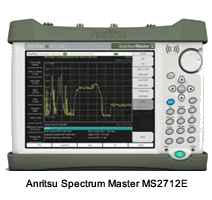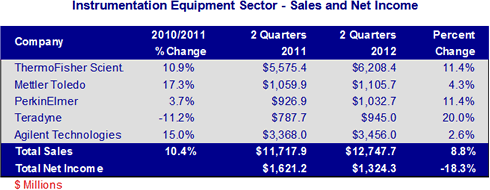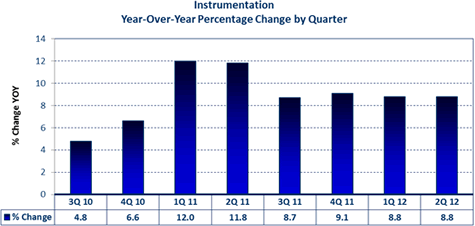The Instrumentation Market for Cable Assemblies, Cellular Drives Growth
 The Instrumentation Market for Cable Assemblies, Cellular Drives Growth
The Instrumentation Market for Cable Assemblies, Cellular Drives Growth
The instrumentation market is comprised of equipment used to test everything from telecommunications equipment to semiconductor products, multi-meters, and oscilloscopes for general manufacturing applications; analytical equipment used in labs; and a host of other products in a variety of industries. The instrumentation equipment market is approximately $100 billion worldwide. The market is currently driven, to a great extent, by two markets — wireless telecommunications and semiconductors.
Wireless telecommunications has seen a boom with the proliferation of smartphones. These devices are a must have for many people, even during tougher economic times. Just look at the recent introduction of the iPhone 5: Apple sold more than 5 million units during the first weekend. Smartphones such as the iPhone 5 operate on the newer 4G/LTE networks. These networks are in demand and are more efficient than the older 3G networks for the service providers to operate at high data consumption, so there is a drive to update the 3G systems in existence and to install 4G/LTE for new services. Global smartphone sales reached over 470 million in 2011 and are forecasted to reach 1.22 billion by 2018.
LTE deployment will also be supported by developing regions like China, India, Latin America, and Eastern Europe, all of which are expanding opportunities and driving growth. Until 2015, China plans to invest around $150 billion in 3G and 4G mobile telecommunications and build 500,000 3G stations. The rapid deployment of 3G and 4G technologies in China is expected to be a growth booster for test equipment such as spectrum analyzers like the Anritsu Spectrum Master MS2712E and Teradyne’s Litepoint IQ series of testers. The general-purpose test equipment market in China is estimated to reach $713.5 million by 2017.
The semiconductor industry is the second driver for growth in the instrumentation market. Each semiconductor wafer, each chip, and each packaged chip require testing. This is accomplished with automatic test equipment made by the instrumentation industry. The 2011 market for semiconductor products was $301 billion in 2011. Although year-to-date semiconductor industry sales are down 5% through June 2012, it is still an immense market with enormous requirements for product testing.
Bishop tracks 13 market sectors for electronic interconnects. The combined annual revenue of all the market sectors was $4 trillion in 2011 and grew 9.7% over 2010. Of the 13 market sectors, instrumentation was the fifth-fastest growing sector in 2011 at 10.4% year-over-year and combined revenues of $24.1 billion. Profitability was up 13% year-over-year to $3.1 billion, and sales growth was well above 2010, which grew 10.4% year-over-year.
For the instrumentation market sector, sales for the first half of 2012 increased 8.8%, year-over-year, compared to 2011. Sales were down 3.1% sequentially in 2Q12 versus 1Q12. Net income as a percent of sales totaled 7.7% for the First Half 2012, down 18.3% year-over-year.
Teradyne had the largest year-over-year increase in sales for the first half of 2012, at 20%. Its sales rose $548 million in the second quarter, of which $365 million was for semiconductor test equipment and $112 million was for wireless test equipment. Perkin Elmer’s sales were up 11.4% for the first half of 2012. Sales in the emerging markets represent approximately 28% of Perkin Elmer total sales, and were responsible for over half of the company’s total organic growth during the second quarter.
Business in China showed strong growth with organic revenues increasing more than 20% and with adjusted operating margins greater than the corporate average. ThermoFisher Scientific had an 11.4% increase in the first half of 2012. Their sales have improved in recent quarters, aided by acquisitions and its expansion into Asia Pacific markets. Growth in India and South Korea, as well as its team in China, also aided in revenue growth, topping 20%. Additionally, the company launched new products last year to expand its mass spectrometry, specialty diagnostics, and laboratory equipment lineup.

As can be seen in the following chart, year-over-year sales growth has been steady for the past four quarters after two strong quarters in early 2011. Sequentially, second quarter 2012 sales decreased 3.2% from the first quarter of 2012.

Impact on the Cable Assembly Industry
Bishop projects the worldwide market for instrumentation cable assemblies to grow 2.1% for 2012. What happens in 2013 and beyond is dependent on social, economic, and political factors worldwide. Factors supporting this include the following:
- Europe has had two quarters of GDP contraction in 2012. It looks likely that this recession will continue through 2012, impacting all market sectors in Europe. Year-to-date, the interconnect industry is down double-digits in Europe and they are expected to stay in that range for the second half of 2012.
- The upgrade of 3G wireless systems to 4G/LTE is likely to continue regardless of economic conditions. The market will be particularly strong in Asia Pacific and other developing economies. This will bode well for the test equipment manufacturers and their cable assembly suppliers.
- With the pervasive presence of semiconductors into all electronic equipment, home appliance, automotive, consumer electronics, etc., the market for semiconductor test equipment and their corollary cable assemblies is expected to remain strong.
Bishop & Associates projects the worldwide market for instrumentation cable assemblies to be up slightly in 2012, to $3.5 billion. The majority of the growth will be in China, Asia Pacific, and ROW, where the expansion will be between 8% to 9% year-over-year.
- The Outlook for the Cable Assembly Industry in 2021 and Beyond - May 18, 2021
- A Data-Hungry World is Driving Demand for Wireless Connections - January 26, 2021
- Innovation and Expansion Drives Growth of Global Cable Assembly Market - May 7, 2019

